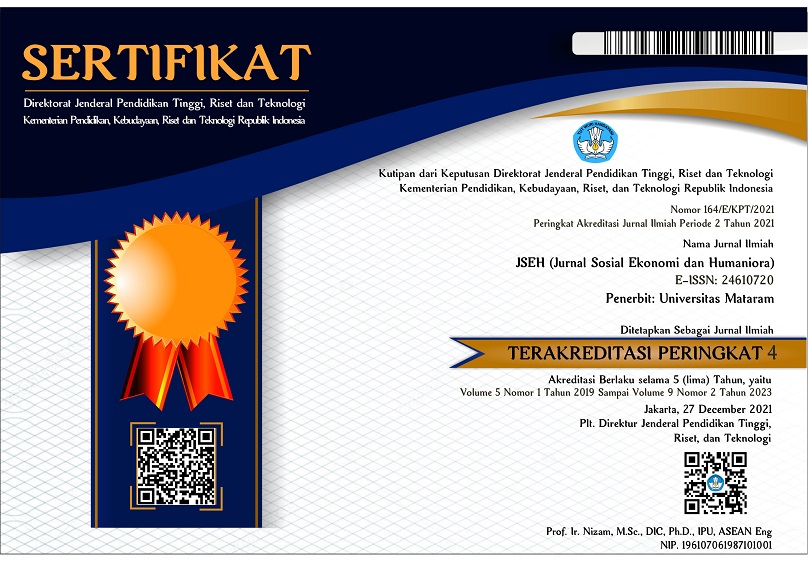Perbedaan Kinerja Bank Perekonomian Rakyat (BPR) Berdasar Kondisi Sebelum, Saat Pandemi dan Awal Transisi Pandemi
DOI:
https://doi.org/10.29303/jseh.v10i2.509Keywords:
Non-Performing Loans, Liquidity, Capital, Profitability, OperationsAbstract
During the Covid-19 pandemic, many economic sectors experienced significant disruption. This also has an impact on the banking sector, including BPR which are financial institutions that play a key role in supporting economic growth at the local level by providing banking services to the MSME sector. This research aims to examine whether Covid-19 has an impact on the banking financial performance of the People's Economic Bank by comparing the performance of BPRs before, during and after the pandemic. The data used is secondary originating from 2018-2021 publications. There are several financial performance ratios used, including Liquidity (Loan Deposit Ratio), Non-Performing Loans, Profitability (Return On Assets), Capital (Capital Adequency Ratio) and operations (Operating Costs and Operating Income). The data was processed using a Mann-Whitney U test using the SPSS 23 application. This research indicate that the performance of BPR banks in the NTB region is able to maintain stability and consistent financial performance in several indicators, such as NPL, ROA, LDR, BOPO and CAR before, during and early in the transition to the Covid-19 pandemic.
References
Amri, A. (2020). Dampak Covid-19 Terhadap UMKM Di Indonesia. Jurnal Brand, 2(1), 123–130. https://www.academia.edu/42672824/Dampak_Covid-19_Terhadap_UMKM_di_Indonesia
Calvina, & Tjokrosaputro, M. (2023). Kinerja Perbankan BPR Sebelum dan Selama Masa Pandemi Covid-19.
Fendel, R., Neugebauer, F., & Zimmermann, L. (2021). Reactions of euro area government yields to Covid-19 related policy measure announcements by the European Commission and the European Central Bank. Finance Research Letters, 42(December 2020), 101917. https://doi.org/10.1016/j.frl.2020.101917
Gina Puspitas, S. (2018). ANALISIS YURIDIS MARGER PERUSAHAAN DAERAH (PD) BPR NTB MENJADI PERSEROAN TERBATAS (PT) BPR NTB. 1–15.
Krieger, K., Mauck, N., & Pruitt, S. W. (2021). The impact of the COVID-19 pandemic on dividends. Finance Research Letters, 42(December 2020), 101910. https://doi.org/10.1016/j.frl.2020.101910
Pengumuman, ‘OJK Beri Izin Usaha Perusahaan Pergadaian Syariah PT Gadai Syariah Berkat Bersama. (2023). Otoritas Jasa Keuangan. In Ojk.Go.Id.
PRATIWI, M. (2017). Dampak COVID-19 Terhadap Perlambatan Ekonomi Sektor UMKM. Impact of Non-Performing Loans on US Product and Labor Markets, 9(3), 135–142. https://doi.org/10.29303/jmm.v11i2.713
Putra, I. N. N. A. (2013). Perbedaan Profitabilitas Dan Tingkat Pengawasan Sebelum Dan Sesudah Merger Pada Bank Perkreditan Rakyat. Jurnal Keuangan Dan Perbankan, 17(2), 302–309. https://jurnal.unmer.ac.id/index.php/jkdp/article/view/749
Putra, I. N. N. A., Mannan, S. S. A., Gumanti, T. A., & Sukendri, N. (2019). The effect of managerial ownership on liquidity, agency cost and performance of credit society banks in West Nusa Tenggara Province of Indonesia. In Business Innovation and Development in Emerging Economies (pp. 124–133). CRC Press.
Rosita, R. (2020). Pengaruh Pandemi Covid-19 Terhadap Umkm Di Indonesia. Jurnal Lentera Bisnis, 9(2), 109. https://doi.org/10.34127/jrlab.v9i2.380
Saputri, R. I. (2018). Analisis Pengaruh CAR, NIM, BOPO dan LDR Terhadap Return Saham Pada Perusahaan Perbankan Yang Terdaftar di Bursa Efek Indonesia Periode Tahun 2011 Sampai dengan Tahun 2015. Jurnal Ekobis Dewantara, 1(1), 149–158. https://www.neliti.com/id/publications/299930/analisis-pengaruh-car-nim-bopo-dan-ldr-terhadap-return-saham-pada-perusahaan-per.
Downloads
Published
How to Cite
Issue
Section
License
Copyright (c) 2024 Otot Bayu Rizki, I Nyoman Nugraha Ardana Putra

This work is licensed under a Creative Commons Attribution-NonCommercial 4.0 International License.








